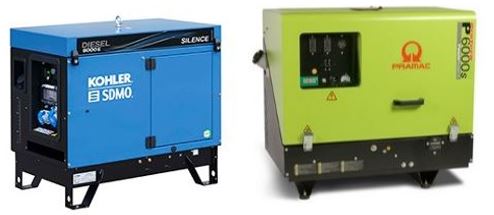GENERATOR, 5-6kVA 230V 50Hz, diesel, silent
NST
PELEGENE0S525
Valid Article
Account code:
61120
Last Updated on:
06/12/2025, 00:15:06
Former
Code(s):
PELEGEND05S- PELEGEND05-
Hazardous materials and products (identified by their 4-digit transport UN-number) must be transported under certain conditions as specified in the MSDS sheet (Material Safety Data Sheet).
The product is part of at least one Kit.
A kit is a collection of products (medical and/or logistic) that are needed for a certain intervention in emergency. The choice and quantity of the articles reflects the MSF protocols for this specific situation. The use of Kits allows to start an intervention without a detailed evaluation.
GENERATOR, 5-6kVA 230V 50Hz, diesel, silent
Definition
Compact silenced diesel generator, INTENDED FOR EMERGENCIES.
Specifications
- diesel engine
- air-cooled
- 3000 rounds per minute
- asynchronous brushless alternator
- single-phase, 230 V AC, 50 Hz
- nominal output power: 5.5 kVA, 4800 W
- mounted on a frame
- low oil cut-out
- power overload protection
- manual ON/OFF switch
- voltage fluctuation: ± 8%
- operating time: minimum 6 hours
- hour counter fitted
- two protected outlets for maximum 32 A (P17)
- noise level: LWA 83 dB(A)
- lifespan limited to 1000 running hours in MSF contexts
Transport Dangerous Goods
Generators might be considered as dangerous goods for transport:
- If a shipper or supplier provides written or electronic documentation stating that a flushing and purging procedure for flammable liquid powered engines has been followed in compliance with Special Provision A70 the generator is not subject to IATA DGR regulations
- If not complying with Special Provision A70 then the generator must be managed in compliance to IATA DGR regulations
Instructions for use
Refer to your technical department for power calculations.
Some models have a 12 V DC outlet. Even if this can be used to charge a battery, it is not recommended to do so. It is better to use a battery charger.
Do not fill the fuel tank when the engine is running.
For maximum safety and earthing, refer to the MSF guidelines on energy.
Maintenance: every 100 hours.
Do not waste time and money on significant repairs.
Precautions for Use
Only supplied in the kit specified below.
Some restricted information has been hidden. Sign in
to see this information


![[KPROKGEND5S] KIT, GENERATOR, DIESEL, 230 V, 50Hz, 5-6 kVA, silenced](/web/image/product.template/550665/image_256/%5BKPROKGEND5S%5D%20KIT%2C%20GENERATOR%2C%20DIESEL%2C%20230%20V%2C%2050Hz%2C%205-6%20kVA%2C%20silenced?unique=e6c8c56)